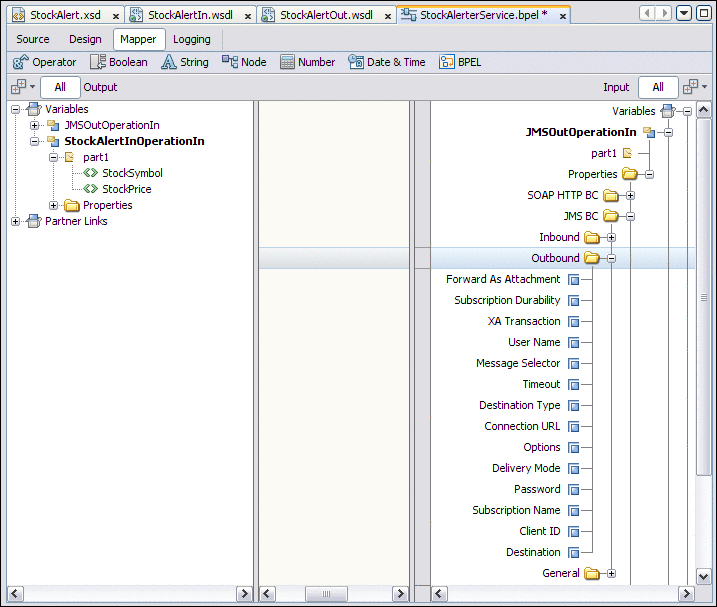Outbound Normalized Message Properties
This category of normalized message properties applies to outbound-only scenarios.
You can access these properties from the left and right panes of the BPEL Mapper. In the following screen capture, the nodes in the right pane are expanded to show the properties.

Connection URL Property (org.glassfish.openesb.jms.outbound.connectionurl)
This property enables you to specify the URL for connecting to the JMS server.
This property is applicable to the following binding types:
-
Receive with Reply
-
Send
-
Send and Wait for Reply
-
On Demand Receive
For more information, see Connecting to the JMS Server.
User Name Property (org.glassfish.openesb.jms.outbound.username)
This property enables you to specify the user name for connecting to the JMS server.
This property is applicable to the following binding types:
-
Receive with Reply
-
Send
-
Send and Wait for Reply
-
On Demand Receive
Password Property (org.glassfish.openesb.jms.outbound.password)
This property enables you to specify the password for connecting to the JMS server.
This property is applicable to the following binding types:
-
Receive with Reply
-
Send
-
Send and Wait for Reply
-
On Demand Receive
Destination Property (org.glassfish.openesb.jms.outbound.destination)
This property enables you to specify the name of the JMS destination to which messages are sent.
This property is applicable to the following binding types:
-
Send
-
Send and Wait for Reply
-
On Demand Receive
Destination Type Property (org.glassfish.openesb.jms.outbound.destinationtype)
This property enables you to indicate whether the JMS destination is a queue or a topic. The valid values are Queue and Topic.
This property is applicable to the following binding types:
-
Send
-
Send and Wait for Reply
-
On Demand Receive
XA Transaction Property (org.glassfish.openesb.jms.outbound.xatransaction)
This property enables you to define the transaction type for the JMS protocol based operation. The valid values are NoTransaction and XATransaction.
This property is applicable to the following binding types:
-
Receive with Reply
-
Send
-
On Demand Receive
Delivery Mode Property (org.glassfish.openesb.jms.outbound.deliverymode)
This property enables you to specify the message delivery mode to use when sending a message. The valid values are PERSISTENT and NON_PERSISTENT.
This property is applicable to the following binding types:
-
Receive with Reply
-
Send
-
Send and Wait for Reply
Timeout Property (org.glassfish.openesb.jms.outbound.timeOut)
This property enables you to specify the timeout in milliseconds on a message consumer receive for a reply message.
This property is applicable to the following binding types:
-
Send and Wait for Reply
-
On Demand Receive
Client ID (org.glassfish.openesb.jms.outbound.clientid)
This property defines a unique client ID.
This property is applicable to the On Demand Receive binding type.
Message Selector Property (org.glassfish.openesb.jms.outbound.messageselector)
This property enables you to filter messages. A message selector consists of a boolean expression, such as Age > 30.
This property is applicable to the On Demand Receive binding type.
Subscription Durability Property (org.glassfish.openesb.jms.outbound.subscriptiondurability)
This property enables you to configure the durability of the topic subscriber. Durable subscribers can survive any disconnection from the JMS server.
The valid values are Durable and NonDurable.
This property is applicable to the On Demand Receive binding type.
Subscription Name Property (org.glassfish.openesb.jms.outbound.subscriptionname)
For durable subscriptions, this property enables you to specify the name of the durable subscription.
This property is applicable to the On Demand Receive binding type.
Forward As Attachment Property (org.glassfish.openesb.jms.outbound.forwardasattachment)
This property enables you to send the message data as an attachment. The valid values are true and false.
For binary data, the data is sent as an attachment by default.
For XML data, sending the data as an attachment prevents the JMS Binding Component from parsing the XML. If the XML is large, then this approach can improve performance.
This property is applicable to the following binding types:
-
Send and Wait for Reply
-
On Demand Receive
- © 2010, Oracle Corporation and/or its affiliates
